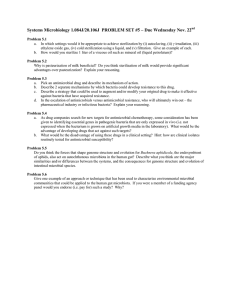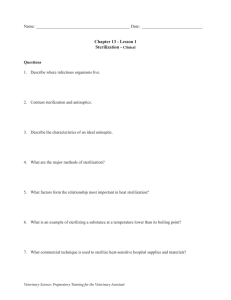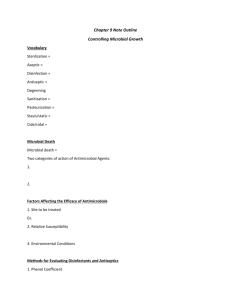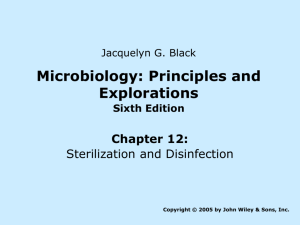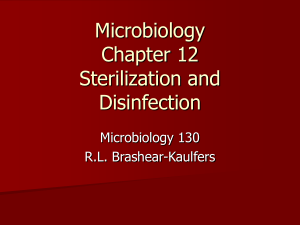20.106J – Systems Microbiology Lecture 16 Prof. Schauer
advertisement
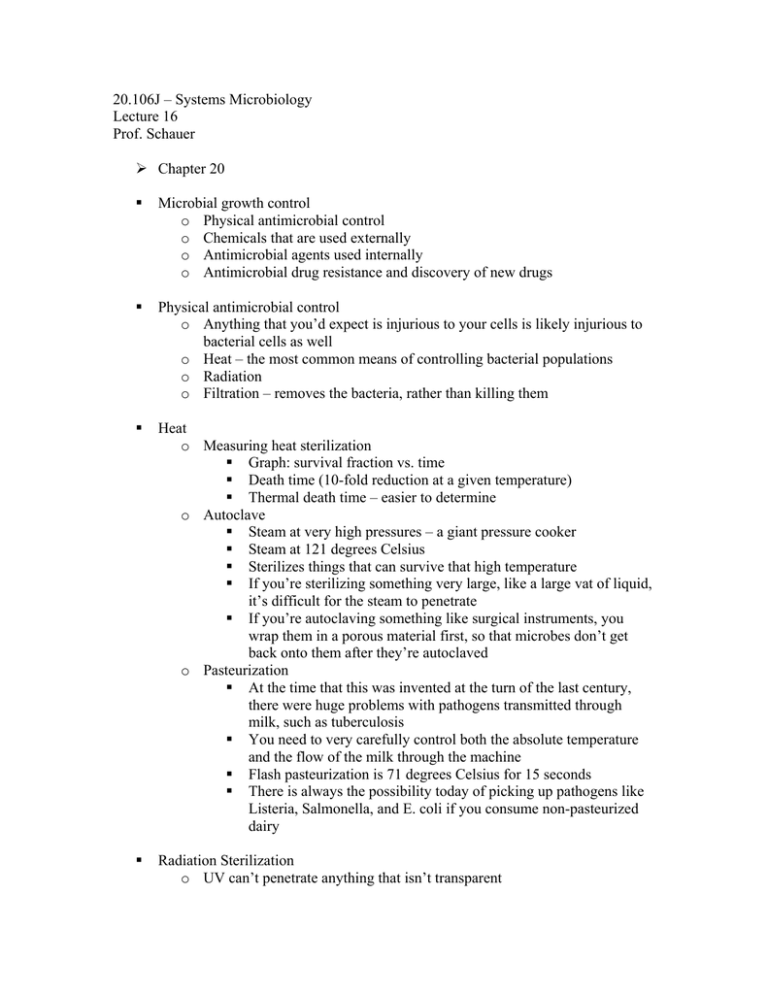
20.106J – Systems Microbiology Lecture 16 Prof. Schauer ¾ Chapter 20 Microbial growth control o Physical antimicrobial control o Chemicals that are used externally o Antimicrobial agents used internally o Antimicrobial drug resistance and discovery of new drugs Physical antimicrobial control o Anything that you’d expect is injurious to your cells is likely injurious to bacterial cells as well o Heat – the most common means of controlling bacterial populations o Radiation o Filtration – removes the bacteria, rather than killing them Heat o Measuring heat sterilization Graph: survival fraction vs. time Death time (10-fold reduction at a given temperature) Thermal death time – easier to determine o Autoclave Steam at very high pressures – a giant pressure cooker Steam at 121 degrees Celsius Sterilizes things that can survive that high temperature If you’re sterilizing something very large, like a large vat of liquid, it’s difficult for the steam to penetrate If you’re autoclaving something like surgical instruments, you wrap them in a porous material first, so that microbes don’t get back onto them after they’re autoclaved o Pasteurization At the time that this was invented at the turn of the last century, there were huge problems with pathogens transmitted through milk, such as tuberculosis You need to very carefully control both the absolute temperature and the flow of the milk through the machine Flash pasteurization is 71 degrees Celsius for 15 seconds There is always the possibility today of picking up pathogens like Listeria, Salmonella, and E. coli if you consume non-pasteurized dairy Radiation Sterilization o UV can’t penetrate anything that isn’t transparent It’s useful for control of surfaces Sometimes it’s useful to sterilize water It’s difficult to achieve complete sterilization with UV Ionizing radiation can achieve sterilization Gamma radiation is also useful – the dose required is a function of the genomic size of the organism you’re trying to eliminate, because gamma radiation has its primary effect on DNA o Typically in medical settings, anything that can’t withstand autoclaving will be exposed to gamma radiation instead. o Sometimes gamma radiation can affect the flavor of the food, although it’s useful in the beef industry o o o o o Filter sterilization o Depth filters Layer upon layer of fibrous materials that form a band You can do it with relatively high volume, with a high flow and a relatively high level of turbidity HEPA filters – important for a number of biomedical applications Air from labs that might contain pathogens is HEPA-filtered and then released into the atmosphere Animals in labs are sometimes housed in HEPA-filtered environments o Membrane filters These serve as a surface against which you can trap particles Some of these filters are very large and high capacity Small-scale membrane filters are often used in labs, such as for solutions or buffers Rotating membrane ultrafiltration (RMU) Vortex-flow filtration (VFF) o The biggest limitation of filtration is that it has a harder time removing smaller organisms, such as microplasma, and viruses Chemical Control Methods o These mechanisms tend to be harmful to human cells in the same way that they’re harmful to bacterial cells o Selective toxicity o Nonselective chemicals, such as bleach, are also useful, but they’re toxic o Bacteriostatic – no permanent change – can continue to grow later o Bacteriocidal – the bacterial drop off very rapidly – it’s permanent o Bacteriolytic o Minimal inhibitory concentration (MIC) Varies depending on media, temperature, the number of organisms you start with You have to determine it in your lab o Chemical agents used externally: Control of nonpathogenic microbes – you might want to remove the microbes for certain industrial processes, such as curing paint. Control of pathogenic microbes – • Sterilants – the same extensive effect as autoclaving – they can remove spores o Toxic gas chambers can sometimes do this o Liquid solutions, like sodium chloride – this might be used for an expensive instrument that you might want to repeatedly sterilize This method is used for flexible endoscopes, which must be sterilized each time they’re used Special devices are made which specially fit the particular device and sterilize it in a controlled manner Devices like these are very expensive • Disinfectants o Decontaminates, gets rid of the infectious population, but it won’t get rid of spores o Lysol is an example • Antiseptics o Disinfectants that are safe to be used topically on human skin o You wouldn’t want to take these internally though Antimicrobials used in vivo o Antibiotics are produced by microbes to inhibit the growth of other organisms Penicillium produced Penicillin, for example o Bacteriocins – produced by E. coli, for example, to act against other strains of E. coli A strain develops a resistance factor, and then develops a bacteriocin that kills all the other cells that don’t have that resistance This gives it an advantage over its neighbors o Arsenic was one of the first antimicrobials – used to treat syphilis o Sulfa drugs are not that useful anymore by themselves – resistance – cells have evolved the ability to use pre-formed folate o However, they can be used with trimethoprim – this and Sulfamethoxazole (“Septra”) work well together o Isoniazid – only used against tuberculosis Unusual lipids in the bacteria are targeted, and there’s no similar human biosynthetic pathway, so it’s very selective Unfortunately, many of the TB microbes have developed resistance o Quinalones Synthetic chemicals – not antibiotics Cipro o Antiobiotics Common targets include • Transcription • Membrane • Ribosomes • Cell wall Penicillin • The first ever discovered • Doesn’t work against gram-negatives Cephalosporins • Commonly used today • Beta lactams • Peptidoglycan • These are fairly allergenic though – many people develop allergies Aminoglycosides • All inhibit protein synthesis • Useful against gram-negative bacteria • Bacteriostatic • These are pretty toxic though • Some cause brain or kidney toxicity • None of these are used as a frontline or first choice Macrolide antibiotics • Arethromycin – used as a first choice in patients who are allergic to penicillin • Bacteria that are resistant to one kind of macrolide are likely resistant to all of them Tetracyclines • Very widely used • If an organism is resistant to one tetracycline then it’s typically resistant to all of them o Antimicrobial drug resistance The development of resistance to a drug that the organism would otherwise be susceptible to. There are a number of ways that organisms can become resistant • They can simply lack the structure that the drug targets, such as a cell wall • They can become impenetrable to the drug • They may be able to modify the drug or the target so that it’s no longer effective • They may develop a new pathway, such as with folate • Some bacteria simply pump the drugs out faster than they take them up, so that the active concentration is so low that it won’t interfere with growth. This works across many different drugs.
